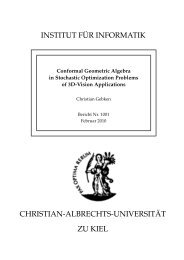Curry: An Integrated Functional Logic Language
Curry: An Integrated Functional Logic Language
Curry: An Integrated Functional Logic Language
Create successful ePaper yourself
Turn your PDF publications into a flip-book with our unique Google optimized e-Paper software.
g :: [a] -> [b] -> ([a],[b])<br />
g x y = (f x, f y)<br />
h :: ([Int],[Bool])<br />
h = g [3,4] [True,False]<br />
However, if the type declaration for g is omitted, the usual type inference algorithms are not able<br />
to infer this type.<br />
5 Expressions<br />
Expressions are a fundamental notion of <strong>Curry</strong>. As introduced in Section 2, functions are defined<br />
by equations defining expressions that are equivalent to specific function calls. For instance, the<br />
program rule<br />
square x = x*x<br />
defines that the function call (square 3) is equivalent to the expression (3*3).<br />
Expressions occur in conditions and right-hand sides of equations defining functions. A computation<br />
evaluates an expression to a data term (see Section 3). Expressions are built from constants<br />
of a specific data type (e.g., integer constants, character constants, see Section 4), variables, or applications<br />
of constructors or functions to expressions. Furthermore, <strong>Curry</strong> provides some syntactic<br />
extensions for expressions that are discussed in this section.<br />
5.1 Arithmetic Sequences<br />
<strong>Curry</strong> supports two syntactic extensions to define list of elements in a compact way. The first one<br />
is a notation for arithmetic sequences. The arithmetic sequence<br />
[ e1 , e2 .. e3 ]<br />
denotes a list of integers starting with the first two elements e1 and e2 and ending with the element<br />
e3 (where e2 and e3 can be omitted). The precise meaning of this notation is defined by the<br />
following translation rules:<br />
Arithmetic sequence notation: Equivalent to:<br />
[e .. ] enumFrom e<br />
[e1,e2 .. ] enumFromThen e1 e2<br />
[e1 .. e2] enumFromTo e1 e2<br />
[e1,e2 .. e3] enumFromThenTo e1 e2 e3<br />
The functions for generating the arithmetic sequences, enumFrom, enumFromThen, enumFromTo, and<br />
enumFromThenTo, are defined in the prelude (see page 53). Thus, the different notations have the<br />
following meaning:<br />
• The sequence [e..] denotes the infinite list [e,e+1,e+2,...].<br />
20
















